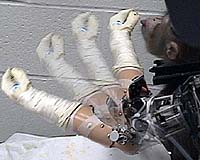 |
Tokyo (UPI) Dec 22, 2010 Robots have been made to run, jump and even dance, but they might be more useful if they could walk like a senior citizen, Japanese researchers say. Scientists at Japan's National Institute of Advanced Industrial Science and Technology have developed a robot that leans on objects in its environment to support itself as it moves around and completes tasks, NewScientist.com reported Wednesday. "Roboticists usually just see objects as obstacles to be avoided," the institute's Sebastien Lengagne says. "But they can help us." Lengagne and his colleagues are developing humanoid robots capable of using their entire bodies and any surrounding objects to move around cluttered environments and complete complex balancing tasks without getting stuck or falling over. "If I ask you to look below your desktop, you will put your hand on the desktop for support," Lengagne says. "But most methods will try to get the robot to do the task without touching the desktop." The robot, HRP-2, acts more like a human, placing both arms on a table to maintain its balance when trying to sit down in a chair or using one arm for support when taking a big swinging kick at a ball, the researchers say.
Share This Article With Planet Earth
Related Links All about the robots on Earth and beyond!
 Robot Arm Improves Performance Of Brain-Controlled Device
Robot Arm Improves Performance Of Brain-Controlled DeviceChicago IL (SPX) Dec 20, 2010 The performance of a brain-machine interface designed to help paralyzed subjects move objects with their thoughts is improved with the addition of a robotic arm providing sensory feedback, a new study from the University of Chicago finds. Devices that translate brain activity into the movement of a computer cursor or an external robotic arm have already proven successful in humans. But in ... read more |
|
| The content herein, unless otherwise known to be public domain, are Copyright 1995-2010 - SpaceDaily. AFP and UPI Wire Stories are copyright Agence France-Presse and United Press International. ESA Portal Reports are copyright European Space Agency. All NASA sourced material is public domain. Additional copyrights may apply in whole or part to other bona fide parties. Advertising does not imply endorsement,agreement or approval of any opinions, statements or information provided by SpaceDaily on any Web page published or hosted by SpaceDaily. Privacy Statement |